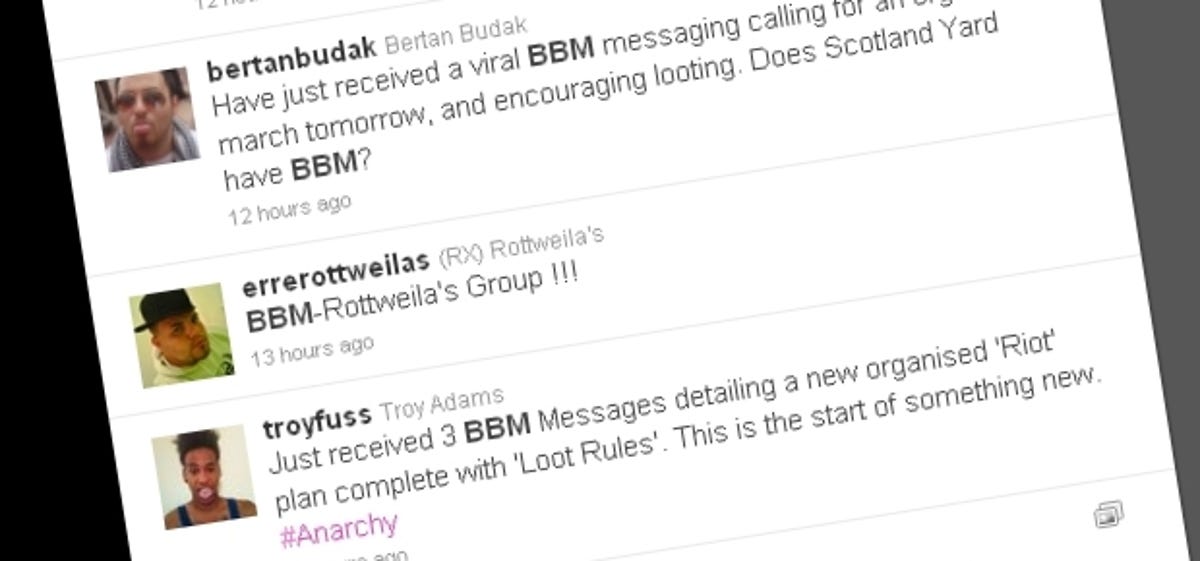
London burned this weekend as rioters and looters took to the streets of Tottenham. It’s been widely reported that the trouble was co-ordinated through Facebook, Twitter and even BlackBerry Messenger, but can we really blame social-media software?
The spotlight has mainly focused on BlackBerry Messenger. BlackBerry phones have a reputation for being worn in the belt holsters of power-suited executives, but they’re also popular with da yoof, thanks to BBM, a free instant messaging service.
Unlike text messages, BBM is free, and you can see when people have read your message. It’s more instant than email, more private than Twitter, and, with BlackBerry Groups and BlackBerry Broadcast Messages, can still be used to publish messages to large groups. Such qualities have seen BlackBerry devices explode in popularity among a younger audience.
This weekend, that younger audience learned from friends of the trouble brewing in Tottenham via their BlackBerry handsets, before the media began covering the nascent riot. BBM beat BBC, you might say.
Tensions have been running high since police shot dead 29-year-old Mark Duggan in Tottenham on Thursday. The Telegraph reported that Duggan sent a message via BBM to his girlfriend shortly before his death, telling her: “The Feds are following me.”
A peaceful protest against the shooting turned into a night of carnage and looting, with PC World, Comet and Carphone Warehouse outlets smashed and cleared out on Saturday night. Cars and buildings burned, and pictures and videos of the violence quickly appeared on Twitter and YouTube. Pockets of violence also flared up in Brixton and east London.
Inevitably, the Daily Mail‘s blunderbuss of blame blasted at Twitter. The Mail described tweets about the riot as a “Twitter frenzy”, and referred to “fears that violence was fanned by Twitter, as a picture of burning police car was retweeted more than 100 times”. The latter comment was, incidentally, made in an article filled with pictures of burning cars and buildings.
Similar tensions within the local community led to rioting in the Broadwater Farm area of Tottenham in 1985. The last time we checked, there was no Twitter or Facebook in 1985.
As always, technology is just a tool. Those who were intent on causing trouble could have communicated via Twitter, BBM or elaborate hieroglyphics, and they would still be to blame, not the tools. Indeed, the Guardian reported that messages circulated on BBM calling for looters to meet in Oxford Circus — but other messages called for an end to the violence.
And let’s not forget the much-lauded role of social media in the popular revolutions that saw the people of Egypt and other countries rise up against oppressive regimes.
BBM has just been updated to BBM6, adding chat to apps and games. The ability to smack talk opponents in games will appeal to the kids, showing that RIM must be aware of its brand’s youth appeal — which makes us wonder why it insists on putting out such boring phones.
Other brands have clearly spotted the success of BBM. Nokia has a free messaging app in the Ovi Store now. Apple is launching a similar service called iMessage in iOS 5, the next big software update for the iPad and iPhone.
If Apple does indeed serve up a cheaper little brother to the iPhone, it may be in the price range of younger phone users and could dethrone BlackBerry as the yoof’s favourite. Let’s hope it doesn’t get used to organise any riots.
Should social media be monitored for social unrest? Should Liking or LOLing at a riot be illegal? Tell us your thoughts in the comments section below or on our Facebook page.
Update: The official BlackBerry UK Twitter account just chirruped, “We feel for those impacted by the riots in London. We have engaged with the authorities to assist in any way we can.”



